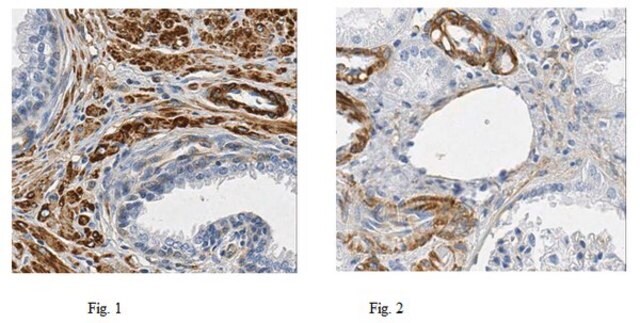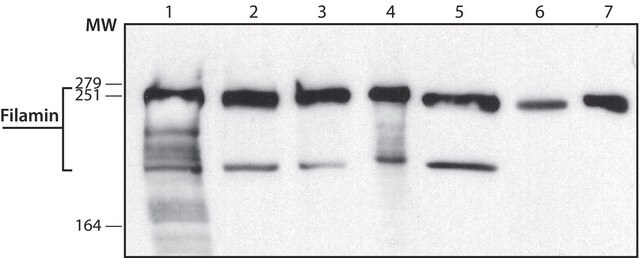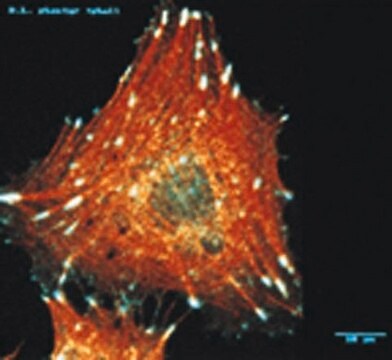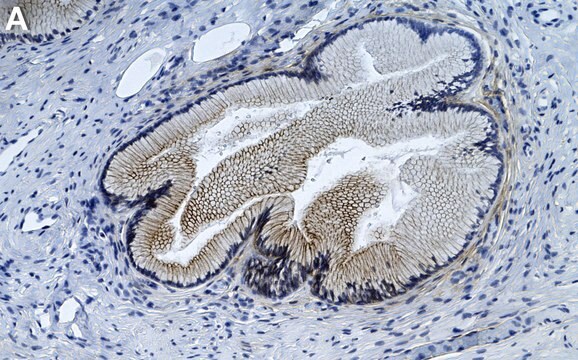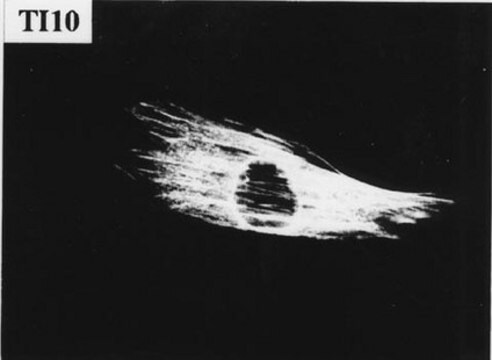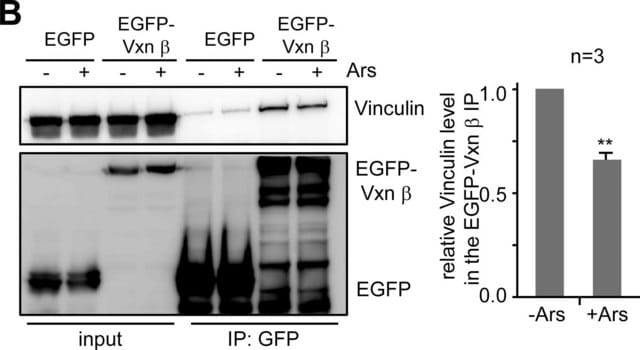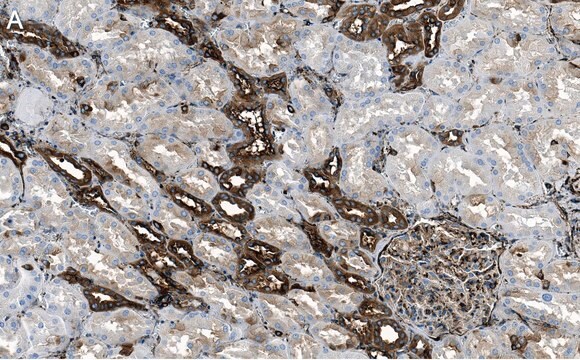Opis ogólny
Dokładamy wszelkich starań, aby dostarczać bardziej ekologiczne produkty alternatywne, które są zgodne z co najmniej jedną z 12 zasad zielonej chemii. To przeciwciało nie zawiera konserwantów, zostało wyprodukowane bez szkody dla zwierząt i jest wyjątkowo stabilne, aby umożliwić wysyłkę i przechowywanie w razie potrzeby, a tym samym jest zgodne z "Zapobieganiem powstawaniu odpadów", "Projektowaniem bezpieczniejszych chemikaliów" i "Projektowaniem pod kątem efektywności energetycznej".
Kliknij tutaj, aby uzyskać więcej informacji.
Przeciwciała 10889 stanowią całkowicie nową generację rekombinowanych przeciwciał monoklonalnych. Każde przeciwciało 10889 jest wytwarzane przy użyciu naszego zastrzeżonego systemu ekspresji rekombinowanej, oczyszczane do jednorodności i precyzyjnie dozowane w celu uzyskania solidnej i wysoce powtarzalnej konsystencji między partiami. Do użytku badaczy udostępniane są wyłącznie klony o najwyższej wydajności. Każde przeciwciało jest walidowane pod kątem wysokiej swoistości i powinowactwa w wielu zastosowaniach, w tym w najczęściej używanym zastosowaniu. Przeciwciała 10889 są niezawodnie dostępne i gotowe do wysyłki, gdy są potrzebne.
Specyficzność
Klon PM6/317 jest mysim rekombinowanym przeciwciałem monoklonalnym 10889, które specyficznie wykrywa filaminę A.
Immunogen
Pełnej długości, oczyszczona Filamina A z ludzkich płytek krwi.
Zastosowanie
Testy kontroli jakości
Oceniane metodą Western Blotting w lizacie komórek A431.
Analiza Western Blotting: Rozcieńczenie 1:1000 tego przeciwciała wykryło Filaminę A w lizatach komórek A431.
Testowane aplikacje
Analiza Western Blotting: Rozcieńczenie 1:1000 z reprezentatywnej partii wykryło Filaminę A w lizacie komórek Jurkat.
Analiza cytometrii przepływowej: 0,1 µg z reprezentatywnej partii wykryło Filaminę A w milionie komórek A431.
Analiza immunocytochemiczna: Rozcieńczenie 1:100 z reprezentatywnej partii wykryło Filaminę A w komórkach HeLa.
Analiza immunohistochemiczna (parafina): Rozcieńczenie 1:100 z reprezentatywnej partii wykryło Filaminę A w wycinkach tkanek ludzkiej prostaty i ludzkiej nerki.
Uwaga: Rzeczywiste optymalne rozcieńczenia robocze muszą zostać określone przez użytkownika końcowego jako próbki, a warunki eksperymentalne mogą się różnić w zależności od użytkownika końcowego.
Opis wartości docelowych
Filamina-A (UniProt: P21333; znana również jako FLN-A, Actin-binding protein 280, ABP-280, Alpha-filamin, Endothelial actin-binding protein, Filamin-1, Non-muscle filamin) jest kodowana przez gen FLNA (znany również jako FLN, FLN1) (Gene ID: 2316) u człowieka. Filamina-A jest wszechobecnym, cytoszkieletowym białkiem homodimerycznym, które wiąże się z filamentami aktyny w cytoszkielecie płytek krwi i łączy tę strukturę z innymi białkami strukturalnymi / sygnalizacyjnymi, takimi jak α-aktynina i receptory błonowe, takie jak receptor vWF (GPIb-IX-V). Ulega również ekspresji w migrujących neuronach w prenatalnej korze nowej. Każdy monomer filaminy A zawiera N-końcową domenę wiążącą aktynę, po której następują 24 tandemowe domeny podobne do immunoglobulin (Ig), przerwane dwoma elastycznymi zawiasami. Dwa monomery dimeryzują poprzez swoją domenę C-końcową, aby wygenerować formę homodimeryczną. Wykazano, że powtórzenie 24 i druga domena zawiasowa są ważne dla tworzenia dimerów. Powtórzenie filaminy 20 oddziałuje z powtórzeniem filaminy 21 maskując miejsce wiązania ligandu na powtórzeniu filaminy 21, co skutkuje konformacją autoinhibicji. Ta autoinhibicja może być złagodzona przez ligandy takie jak ITGB7 lub FBLIM1. Filamina-A promuje ortogonalne rozgałęzianie filamentów aktyny i łączy filamenty aktyny z glikoproteinami błonowymi. Kotwiczy różne białka transmembranowe do cytoszkieletu aktyny i służy jako rusztowanie dla szerokiej gamy cytoplazmatycznych białek sygnalizacyjnych. Odgrywa również rolę w kontaktach komórka-komórka i połączeniach adhezyjnych podczas rozwoju naczyń krwionośnych, serca i narządów mózgu oraz odgrywa rolę w morfologii płytek krwi poprzez interakcję z SYK, która reguluje sygnalizację receptorów zawierających ITAM i ITAM-podobne. Podczas procesu prowadzenia aksonów, Filamina-A jest wymagana do zapadania się stożka wzrostu indukowanego przez stymulację neuronów za pośrednictwem SEMA3A. Jej fosforylacja przy serynie 2152 przez PKA jest negatywnie regulowana przez jej autoinhibicyjną konformację. To rekombinowane przeciwciało monoklonalne 10889, generowane przez naszą zastrzeżoną technologię, oferuje znacznie zwiększoną swoistość, powinowactwo, powtarzalność i stabilność w porównaniu z konwencjonalnymi przeciwciałami monoklonalnymi. (Ref.: Ithychanda, SS., et al. (2015). J. Biol. Chem. 290(13); 8527-8538; Page, RC., et al. (2011). Acta Crystallogr. Sect F Struct. Biol. Cryst. Commun. 67(8); 871-876).
Postać fizyczna
Oczyszczone rekombinowane mysie przeciwciało monoklonalne IgG, liofilizowane w PBS z 5% trehalozą, o normalnym wyglądzie gruboziarnistej lub półprzezroczystej żywicy. Składniki PBS/trehaloza w preparacie ZooMAb mogą mieć wygląd półstały (żel przypominający kulki) po liofilizacji. Jest to zjawisko normalne. Należy postępować zgodnie z zalecaną procedurą rekonstytucji zawartą w arkuszu danych, aby rozpuścić półstały, przypominający kulki materiał o wyglądzie żelu. Otrzymany roztwór przeciwciała jest całkowicie stabilny i funkcjonalny, co potwierdzają pełne testy funkcjonalne. Nie zawiera biocydów ani konserwantów, takich jak azydek, ani żadnych produktów ubocznych pochodzenia zwierzęcego. Większe opakowania są dostarczane jako wielokrotności 25 µL.
Przechowywanie i stabilność
Zaleca się przechowywanie liofilizowanego produktu w temperaturze 2-8°C. Przed rekonstytucją fiolki należy krótko mikrowirować, aby odwirować materiał na dno fiolki. Każdą fiolkę należy odtworzyć, dodając 25 µl przefiltrowanej wody laboratoryjnej lub PBS. Odtworzone przeciwciała można przechowywać w temperaturze 2-8°C lub -20°C w celu długotrwałego przechowywania. Unikać wielokrotnego zamrażania.
Inne uwagi
Stężenie: Stężenie specyficzne dla danej partii można znaleźć w certyfikacie analizy.
Informacje prawne
ZooMAb is a registered trademark of Merck KGaA, Darmstadt, Germany
Oświadczenie o zrzeczeniu się odpowiedzialności
O ile nie określono inaczej w naszym katalogu lub innej dokumentacji firmy dołączonej do produktu(-ów), nasze produkty są przeznaczone wyłącznie do użytku badawczego i nie mogą być wykorzystywane do żadnych innych celów, w tym między innymi do nieautoryzowanych zastosowań komercyjnych, zastosowań diagnostycznych in vitro, zastosowań terapeutycznych ex vivo lub in vivo lub jakiegokolwiek rodzaju konsumpcji lub zastosowania u ludzi lub zwierząt.
Ta strona może zawierać tekst przetłumaczony maszynowo.

